This article explains how to install a tire plug to fix a flat car tire.
The other day I drove about 2 miles between office buildings, briefly went inside the office and returned to my car about 5 minutes later to find the driver’s side rear tire was completely deflated and flat!
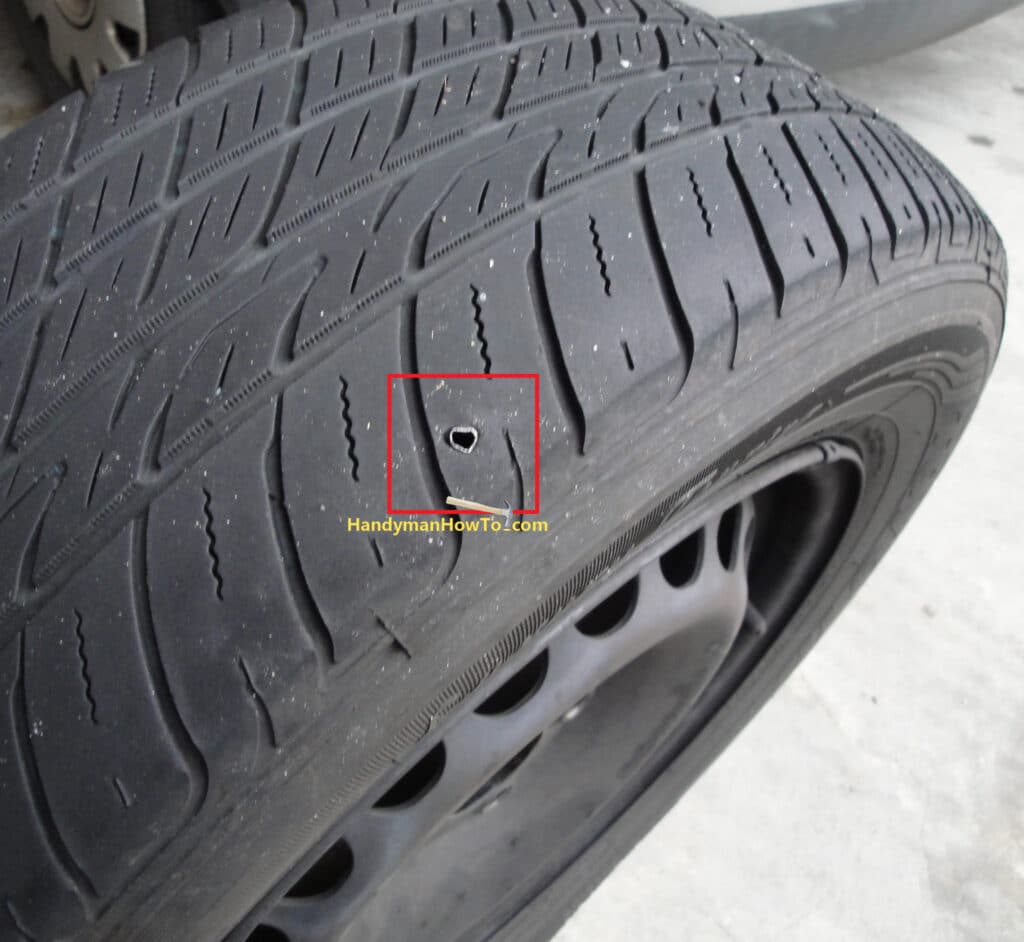
Fortunately I was in a parking garage and quickly changed the flat, swapping it for the full size spare tire in the trunk. Later I found that I had run over a metal tube that was perfect for letting all the air out of the tire.
Flat Car Tire Repair Options
There are several options for repairing a flat tire:
- Fix-A-Flat aerosol inflator and similar products.
- Tire plug (described here).
- Take the flat tire to a repair shop for professional evaluation and repair with a inside patch and plug.
- Call for Emergency Roadside Assistance using your American Automobile Association membership.
Aerosol Inflators
The Fix-A-Flat aerosol inflator is a temporary repair in-a-can that will seal small punctures and inflate the car tire to get you back on the road until you can reach a repair shop. The primary advantage of Fix-A-Flat is it easy to use, even by my wife who otherwise would have no clue how to put on the spare tire. A disadvantage of aerosol sealants is the car tire and/or rim needs to be cleaned. Just let the garage staff know and they’ll take care of the cleaning.
Car Flat Tire Plug
Tire plugs are a temporary repair for tread punctures up to 1/4 inch in diameter according to the Rubber Manufacturers Association (RMA), although plugs are often used as long term repairs.
Plugs are the subject of differing opinions; I called half-dozen tire shops and the recommendations were about evenly split between “we plug” and “we patch and plug”. All tire shops would patch and plug if requested. A typical plug repair quote was $14 compared to a patch-and-plug for $28. The “we plug” shops said plugs worked just fine and that’s what they recommend for most repairs.
I personally have never had a plug repair fail on a repair for a small puncture from a nail, screw and the like.
Plugs should not be used to repair damaged sidewalls. A plug shouldn’t be trusted on high speed performance tires; if you have an expensive performance tire have it professionally repaired.
Professional Flat Car Tire Repair
The best and safest decision is to have your tire professionally evaluated, repaired (or replaced) at a tire shop. Especially if you’ve driven with the tire low on air or flat. The sidewalls and/or tread might be damaged beyond repair, although it might look OK to the untrained eye.
This reminds me of the time I saw a woman driving a Jaguar Vanden Plas on the shoulder of the highway in Boca Raton, FL with a rear flat tire. Rather than stopping at the first sign of trouble, she kept driving long after the tire disintegrated and was running on the metal rim with sparks flying. The wheel rim is destroyed and rims are way more expensive to replace than a tire.
Emergency Roadside Assistance
There are many Roadside Assistance programs available, often from your auto insurance company, automobile manufacturer, or the American Automobile Association (AAA). I have an AAA Plus membership for my wife and myself that I paid $118/year – Google for AAA membership discounts. The AAA Plus membership features 100 mile towing – which will get me home 99% of the time – along with battery, free fuel, vehicle locksmith and flat tire service.
If my flat tire had happened on a rainy, muddy night stuck on the side of the road instead of inside a parking garage, I would’ve called AAA to put on the spare tire. When you’re back home, you can evaluate tire repair options at your leisure.
When to Plug Flat Car Tire
A car tire plug was suitable for my situation because:
- The tire was not driven while flat and therefore has no sidewall damage.
- The tire tread is in good shape with about 30% remaining tread depth/life.
- The tire is not an expensive high performance tire.
- The puncture is the tread.
- The puncture is less 1/4 inch in diameter.
- I already had the tire off the car, having put on the spare.
- I’m acutely aware of how my car drives and know when things aren’t quite “right”.
- I’ll do a quick visual check of the tire each time before I drive to see it’s not low air.
- I understood my tire repair options and risks.
On the other hand, if this were my wife’s minivan, I’d have the tire patched and plugged by professional because she will blissfully drive so long as the engine starts. It’s not that she doesn’t care, she just isn’t “tuned in” to mechanical issues. More than once I’ve driven the minivan with her, and asked “How long has it been making that noise?” (squeaky break pads) or “Why didn’t you tell me about that vibration when braking?” (warped rotor) or “Do you notice it’s not tracking straight?” (wheels out of alignment). Her response is invariably “I don’t know” or “What are you talking about?”. Sigh.
How to Plug Flat Car Tire
Plugging a car tire is simple, quick and I’ve had excellent experiences with tire plugs on the handful of occasions that I’ve run over a nail or screw, with the plug lasting the life of the tire. I bought a Victor Tire Repair Kit for about $6 at auto parts as shown here.
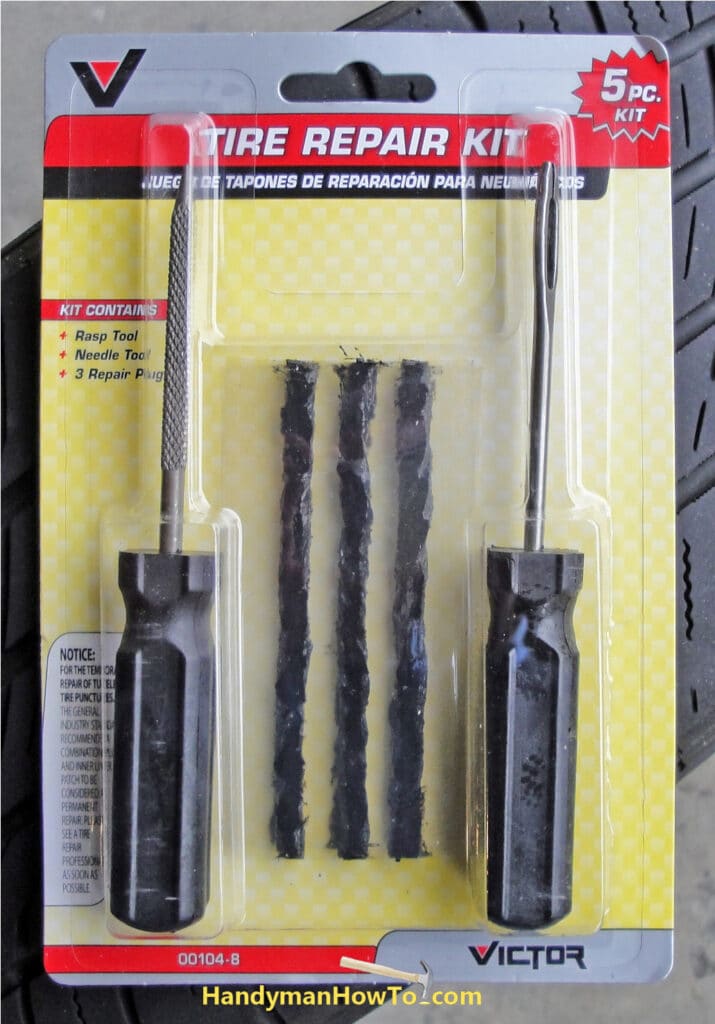
The metal object is pulled out with sturdy pair of needle nose pliers. It took several attempts to get a grip and pull it out, little by little.

Wow! How long is this thing?! The car tire puncture was caused by a metal tube over 3 inches long!
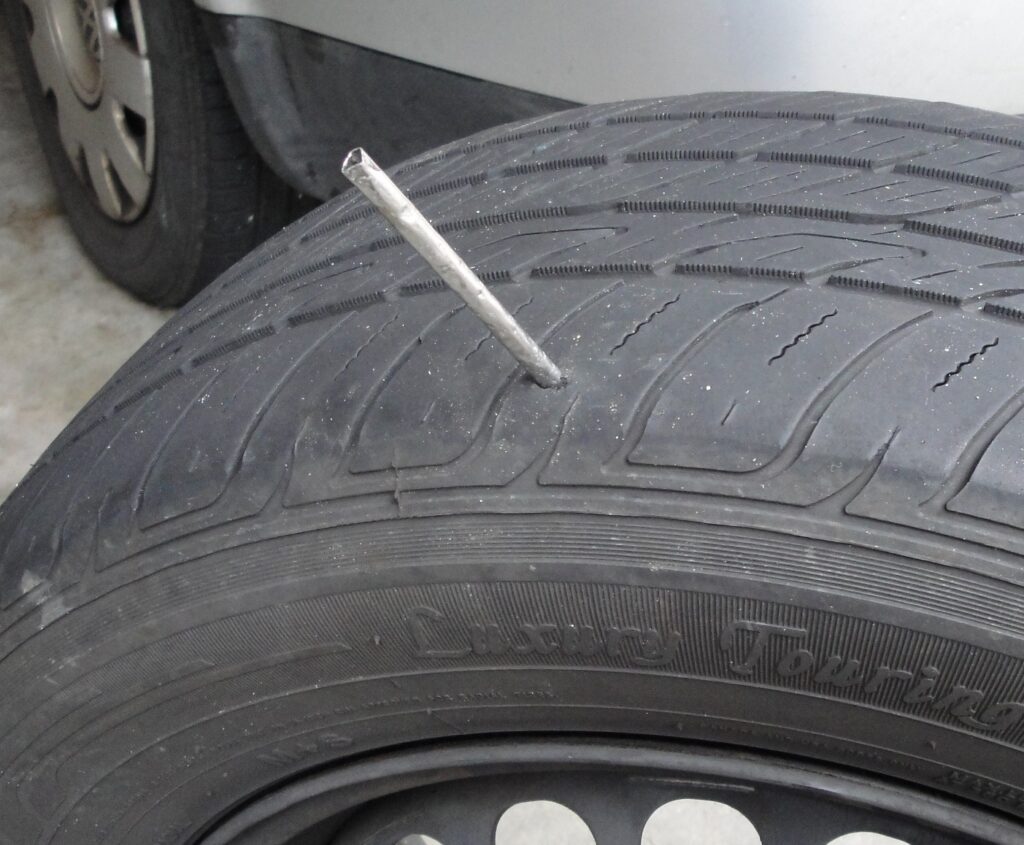
A 3/16 inch diameter by over 3-1/2 inch long metal tube punctured the car tire! The metal tube is surprisingly strong, I couldn’t bend it with two hands, and it smelled strongly like brake fluid. It appears to have fallen off a car or piece of machinery.
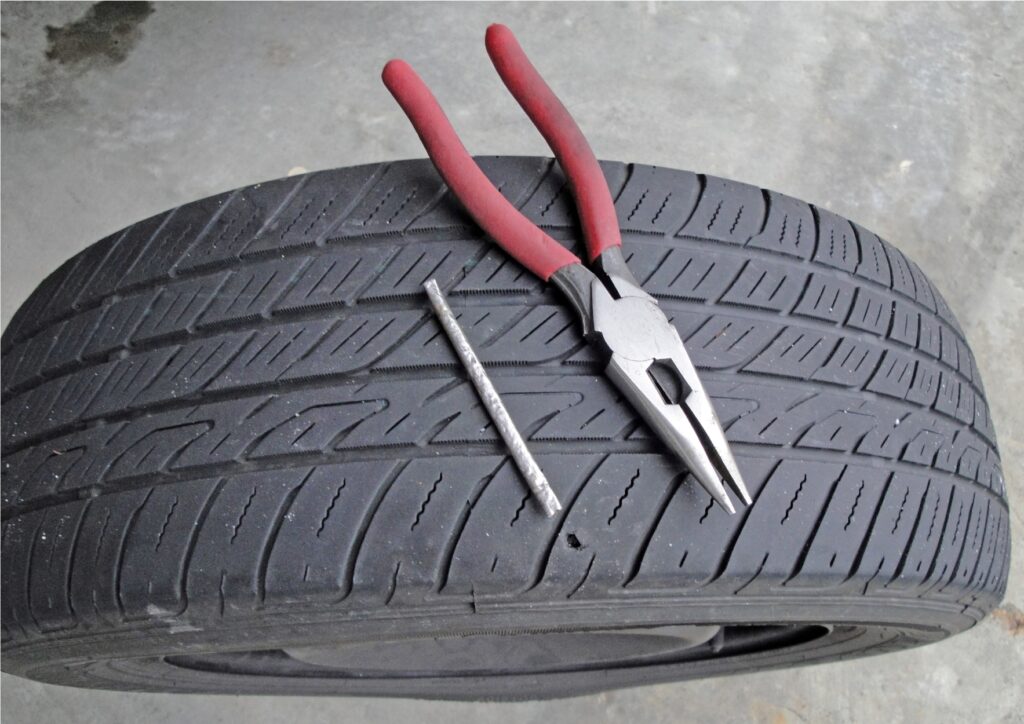
Flat Car Tire Plug Repair Kit
This is the Victor plug repair kit. Note the puncture car tire hole at the red arrow:
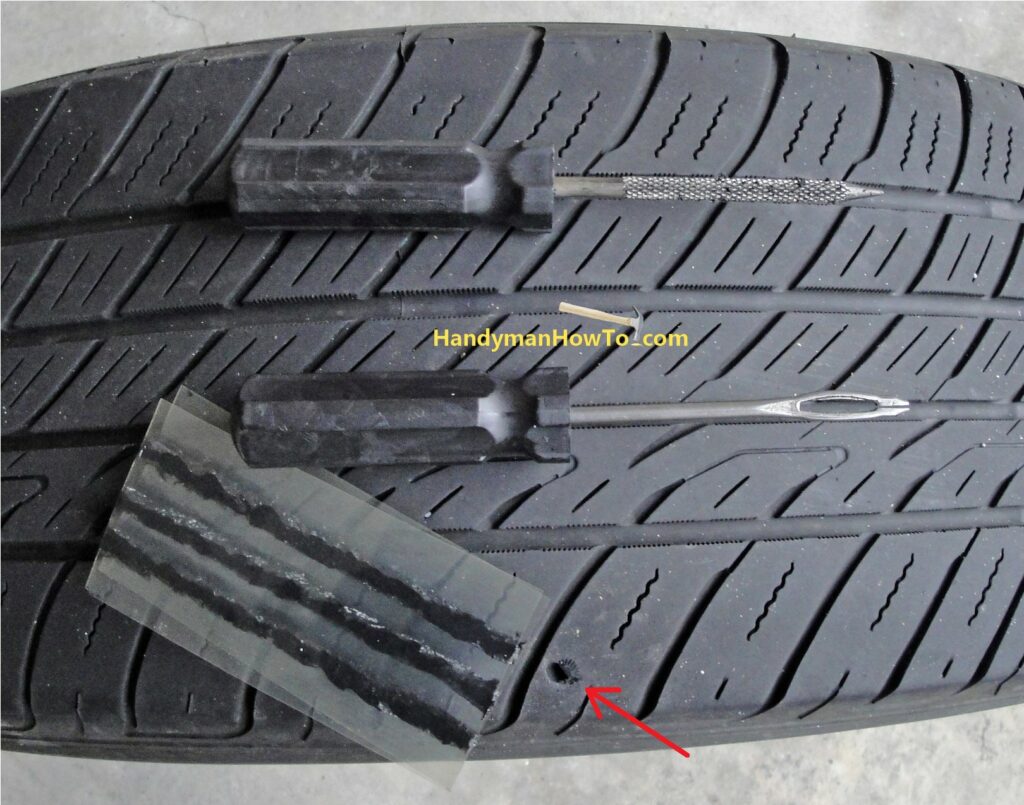
The car tire puncture hole is cleaned with the rasp tool by drawing it back and forth several times to remove any dirt, mud or grease that would interfere with the bond between the tire rubber and tire plug:

The flat tire plug is woven cord coated in a sticky tar-like substance:

The tire plug is threaded through the eye of the needle tool, centered halfway as shown:
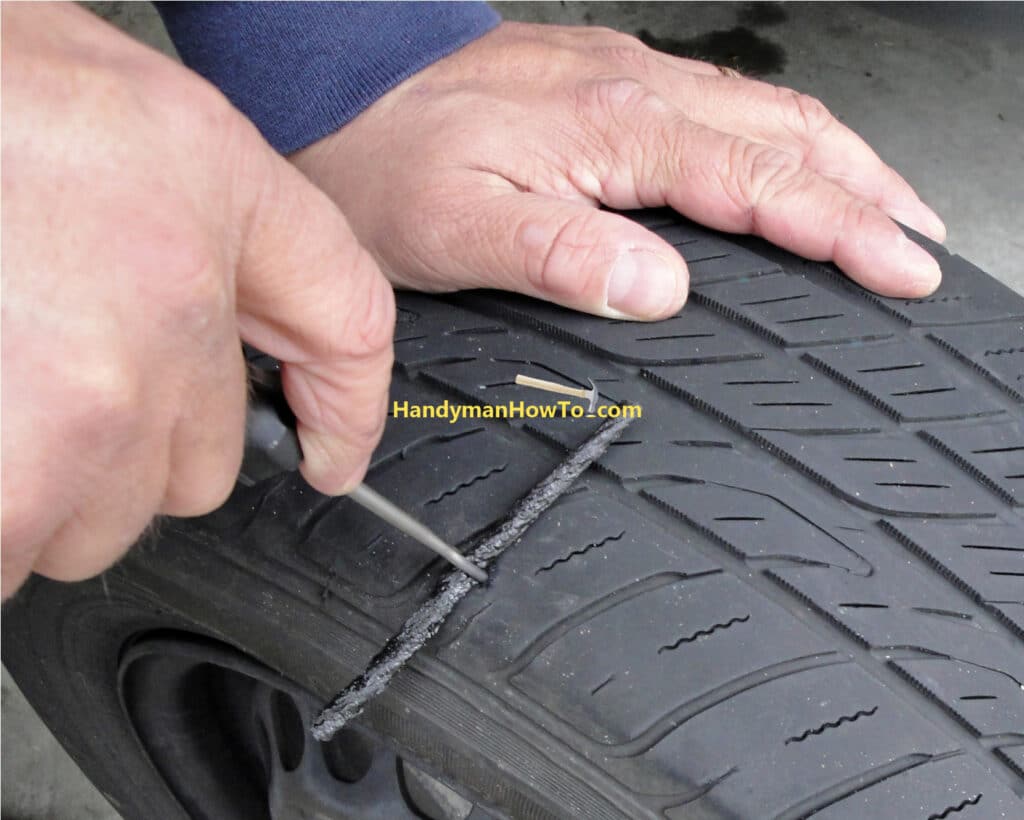
It takes a fair amount of force to press the needle tool and plug into the car tire. Press straight in, do not twist.
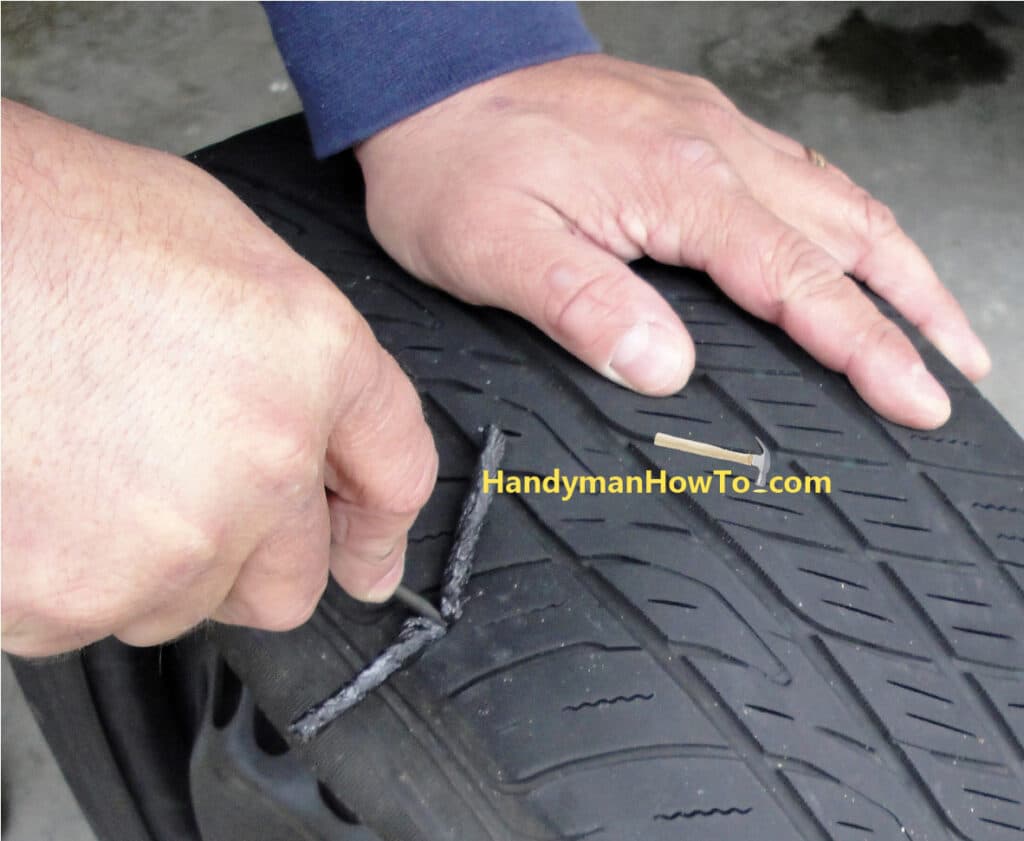
The tire plug is pressed about 2/3rds of the way into the car tire, then the needle tool is forcefully drawn straight out to set the plug. This was the hardest part and took a lot of muscle.
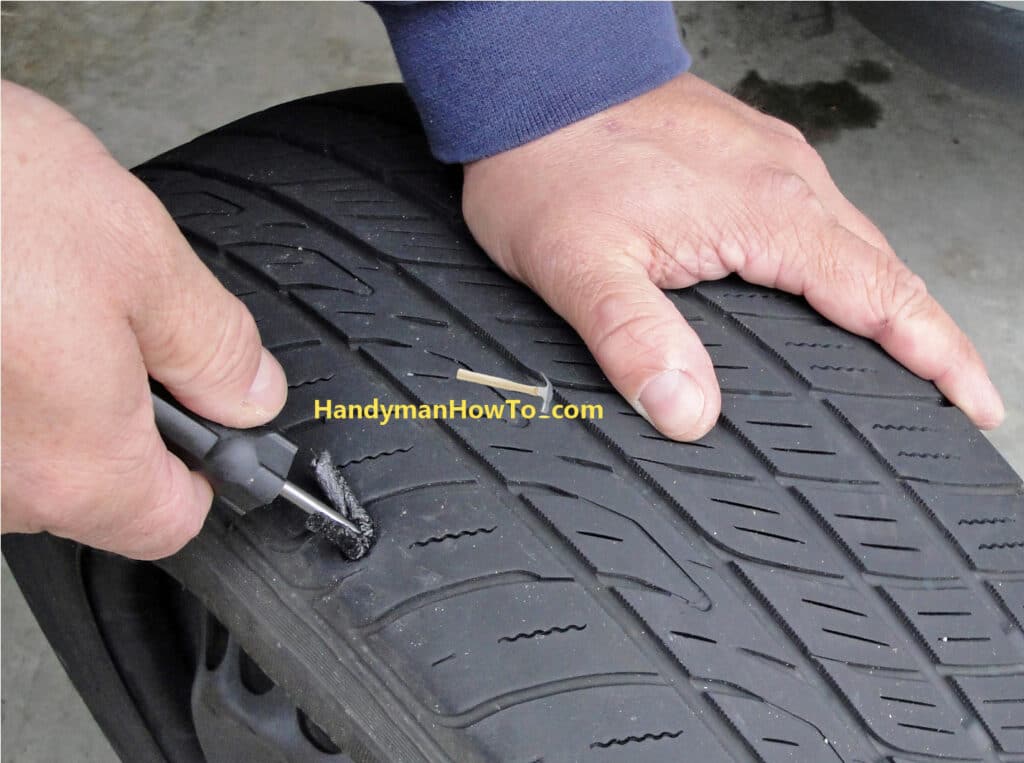
The car tire plug remains in the hole after the needle tool is withdrawn. The newly installed tire plug:
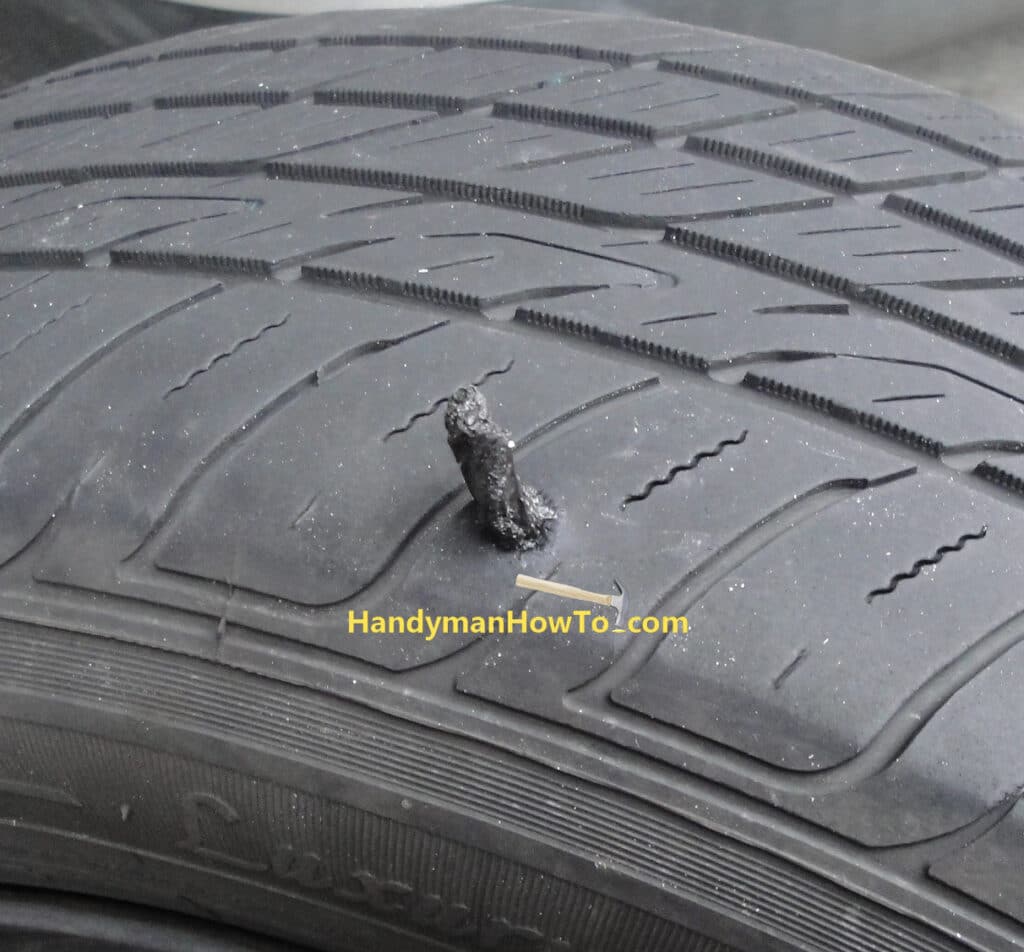
Cut the tire plug off roughly even with the tire tread:
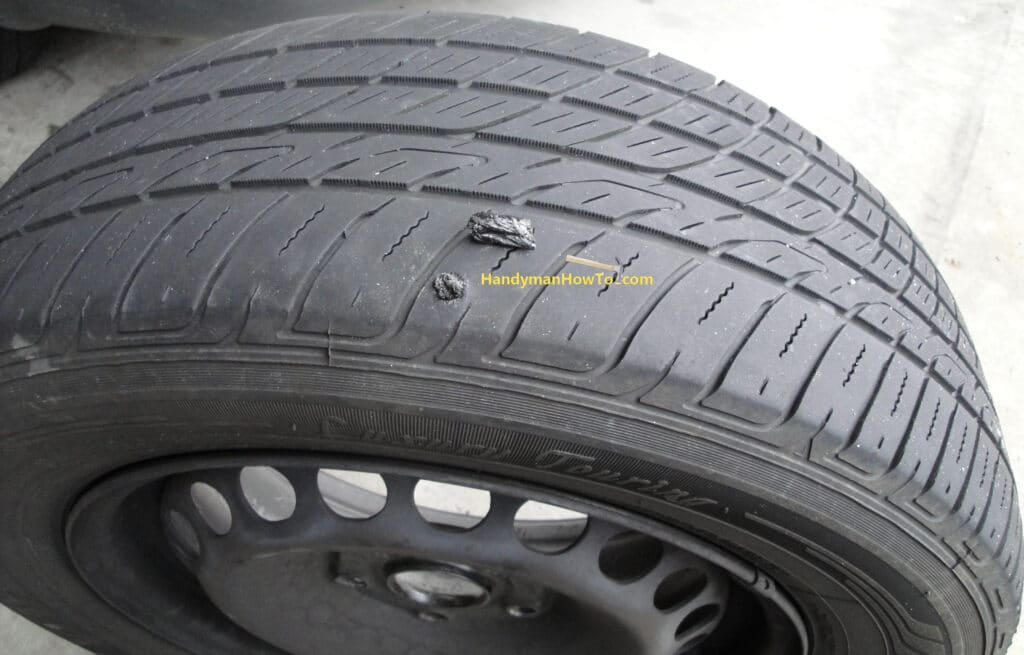
A small portable air compressor is used to re-inflate the tire. It takes more than one tank of air to fully inflate the tire, so the compressor needs to be plugged in to the 120VAC outlet to do the job.
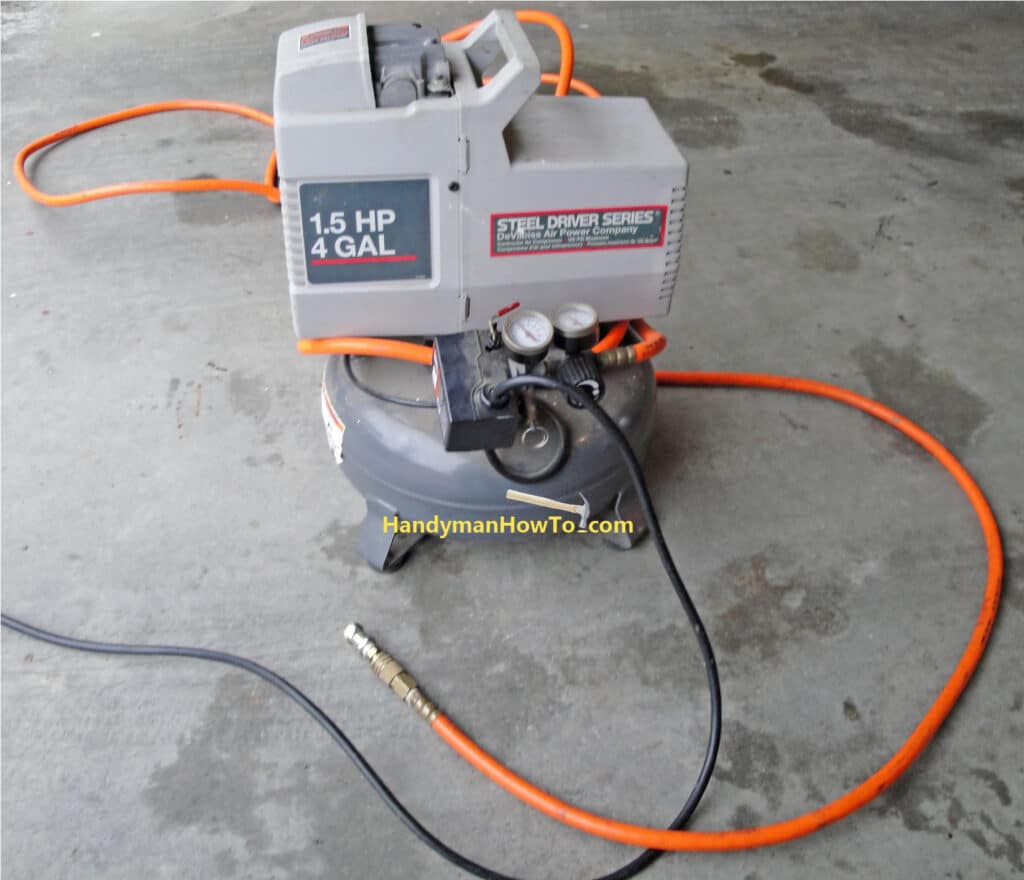
A portable air compressor that plugs into the cigarette lighter also works great:
Refer to your owner’s manual for the recommended tire inflation pressure – on my car, it’s 39 psi. Do not exceed the maximum tire pressure printed in raised letters on the sidewall.
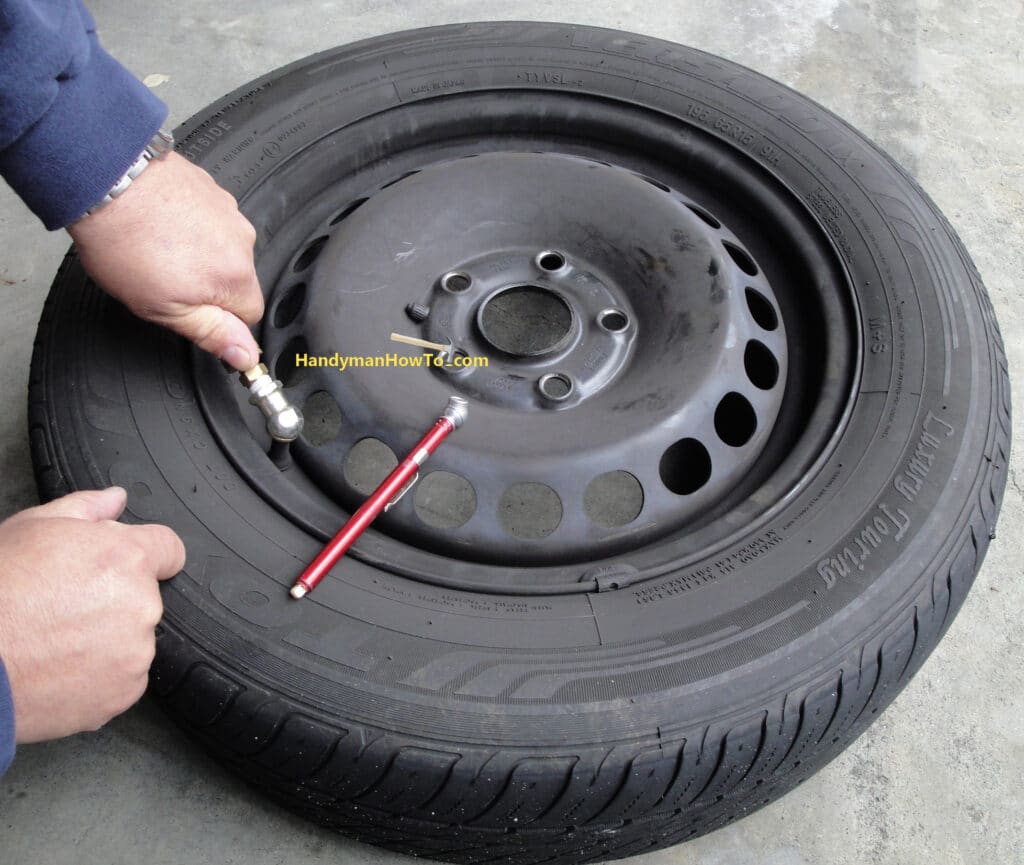
Check the tire pressure with the gauge several times as you inflate the tire. Here I’m showing 42 psi on the tire pressure pencil gauge. I let out small amount of air to bring the pressure down to the recommended 39 psi.
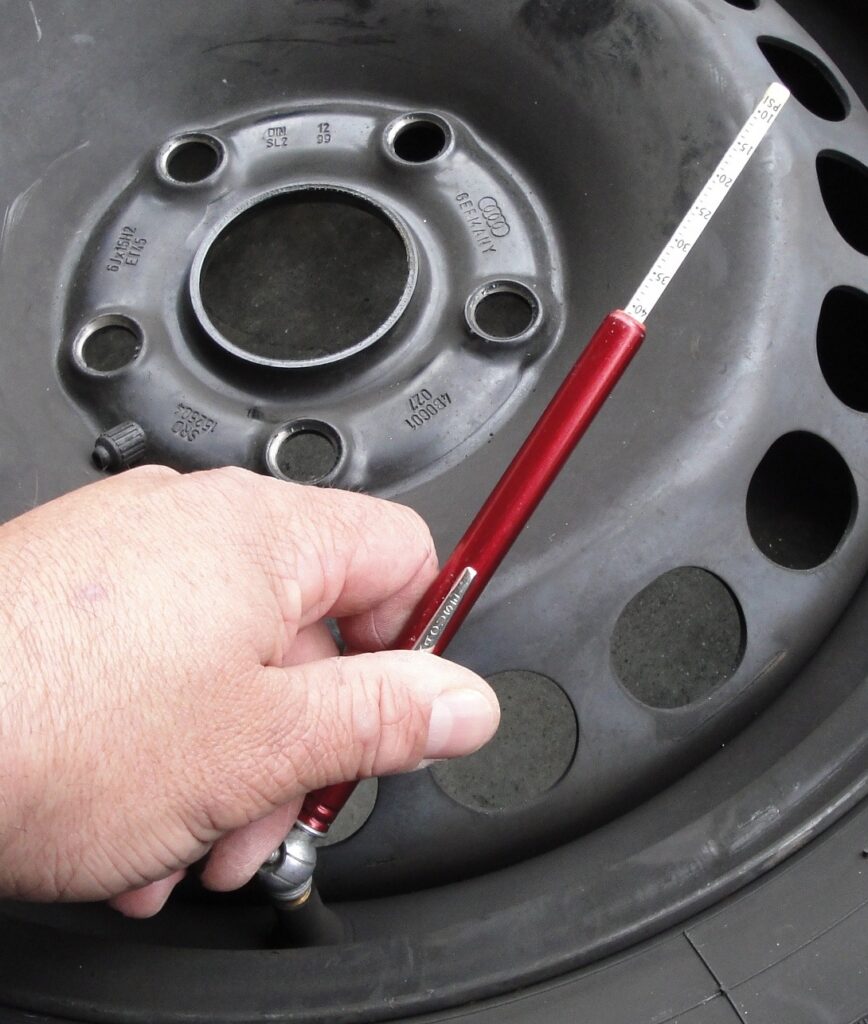
The tire is now ready to be mounted back on the car.
Plugged Flat Car Tire Re-Balancing
It’s possible the tire plug can add enough weight that the tire needs to be rebalanced. I’ve never noticed a balancing problem with a plug repair nor has my plugged tires ever developed a vibration or flat spot that is characteristic of an unbalanced tire. However, if you notice a vibration that increases with speed or which happens at a specific speed range (it’s worse at a harmonic frequency), then have your tire rebalanced. While you’re at the repair shop with the tire off the car to have it rebalanced, you might as well have the tire patched-and-plugged professionally per the Rubber Manufacturers Association recommendations.
Tip:
Press your thumb into the sidewall and note how firm the tire feels. Remember this for a quick check with your visual inspection to ensure the tire is holding air each time before you drive. If in doubt confirm the tire pressure with the tire gauge when the tire is cold.
Thanks for reading,
Bob Jackson